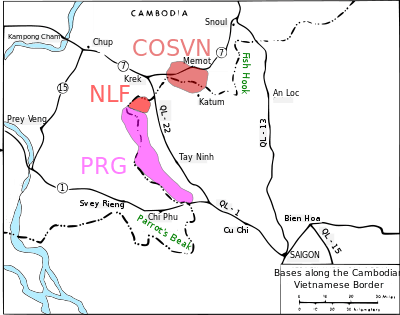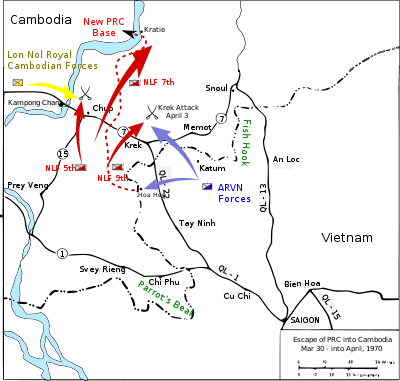Escape of the Provisional Revolutionary Government
| Escape of the Provisional Revolutionary Government | |||||||
|---|---|---|---|---|---|---|---|
| Part of the Vietnam War | |||||||
 Location of bases in early 1970 | |||||||
| |||||||
| Belligerents | |||||||
|
|
| ||||||
| Commanders and leaders | |||||||
|
|
B-3 Front: | ||||||
The Escape of the Provisional Revolutionary Government was a series of military operations conducted in eastern Cambodia during mid-1970 by the Republic of Vietnam (South Vietnam) during the Vietnam War. The objective was to search and destroy head corridor elements of the Provisional Revolutionary Government of the Republic of South Vietnam (PRG), National Front for the Liberation of South Vietnam (NLF) or Viet Cong (VC) and Central Office for South Vietnam (COSVN).
A change in the Cambodian government allowed a window of opportunity for the destruction of the base areas in 1970 when Prince Norodom Sihanouk was deposed and replaced by pro-American General Lon Nol. The pro-American Lon Nol demanded the Vietcong forces to leave Cambodia, they refused and took control of much of the East and North of Cambodia. Lon Nol and the South Vietnamese responded by launching an invasion of the border region and forcing the anti government fighters to leave the area to safer Vietnamese controlled Kratie provinces to the north. Some elements of the anti government forces including the PRG left the area while under pressure from Cambodian and South Vietnamese forces. This operation was seen as a precursor to the much larger Cambodian Campaign a month later.[1]
Background
The People's Army of Vietnam had been utilizing large sections of relatively unpopulated eastern Cambodia as sanctuaries into which they could withdraw from the struggle in South Vietnam to rest and reorganize without being attacked. These base areas were also utilized by the communists to store weapons and other material that had been transported on a large scale into the region on the Sihanouk Trail. During 1968, Cambodia's indigenous communist movement, labeled Khmer Rouge (Red Khmers) by Cambodian King Norodom Sihanouk, began an insurgency to overthrow the government. While they received very limited material help from the North Vietnamese at the time (the Hanoi government had no incentive to overthrow Sihanouk, since it was satisfied with his continued "neutrality"), they were able to shelter their forces in areas controlled by PAVN/NLF troops.[2]
While Sihanouk was abroad in France for a rest cure in January 1970, government sponsored anti-Vietnamese demonstrations erupted throughout Cambodia.[3] Continued unrest spurred Prime Minister/Defense Minister Lon Nol to issue an ultimatum on 12 March to the North Vietnamese to withdraw their forces from Cambodia within 72 hours.[4]
On 18 March, the Cambodian National Assembly officially deposed Sihanouk and named Lon Nol as provisional head of state. The North Vietnamese response to the coup was swift. Even before Lon Nol's 12 March ultimatum PAVN had begun expanding its logistical system from southeastern Laos (the Ho Chi Minh trail) into northeastern Cambodia.[5] After Lon Nol's anti-Vietnamese movements PAVN also launched an offensive (Campaign X) against the Cambodian army, quickly seizing large portions of the eastern and northeastern parts of the country, isolating and besieging or overrunning a number of Cambodian cities including Kampong Cham.
Escape to Kratie

In early 1970 North Vietnamese intelligence in the Cambodian capital of Phnom Penh knew that Sihanouk was coming under intense pressure to remove Vietnamese bases off Cambodian soil. Planning for any eventuality the North Vietnamese started planning emergency evacuation routes in the event of a coordinated assault by Cambodians to the West and South Vietnamese to the East. After the Cambodian coup the COSVN was evacuated on 19 March 1970.[6] While the NLF and PRG bases were preparing to also move to the north and safety they came under aerial bombardment from American B-52 bombers on 27 March.[6] As laid out by the evacuation plans General Hoàng Văn Thái planned to have three Divisions to cover the escape.[7] The NLF 9th Division would block any movement from the South Vietnamese army, the NLF 5th Division would screen any forces that the Cambodians sent and the NLF 7th would provide security to the civilian and military members of the PRG and NLF bases.[7]
Moving across the border in Cambodia on 30 March elements of the PRG and NLF were surrounded in their bunkers by South Vietnamese forces flown in by helicopter.[8] Surrounded they awaited till nightfall and then with security provided by the 7th they broke out of the encirclement and fled north to unite with the COSVN in the Cambodian Kratie province.[8] Trương Như Tảng was the Minister of Justice in the PRG and he recounts that during the march to the northern bases was day after day of forced marches in the rain.[7] Just before the column crossed route 7 on their way north they received word that on 3 April the 9th Division had fought and won in a battle near the city of Krek, Cambodia against ARVN forces.[9]
Years later Trương would recall just how "close [South Vietnamese] were to annihilating or capturing the core of the Southern resistance – elite units of our frontline fighters along with the civilian and much of the military leadership.[7] After many days of hard marches the PRG reached the northern bases, and relative safety, in the Kratie region. Casualties were light and the march even saw the birth of a baby to Dương Quỳnh Hoa the deputy minister of health in the Provisional Revolutionary Government (PRG). The column needed many days to recover and Trương himself would require weeks to recover from the long march. Near the end of April as the skeleton crew that was left behind to man the PRG, NLF and COSVN bases were finally forced from their positions by the coordinated campaign from the South Vietnamese and American forces in what would be later known as the Cambodian Campaign.
Bibliography
- Notes
- References
- Deac, Wilfred P. (1997). Road to the Killing Fields: The Cambodian War of 1970–1975 (1997 ed.). Texas A&M University Press. ISBN 978-1-58544-054-2. - Total pages: 320
- Gilster, Herman L. (2002). The Air War in Southeast Asia: Case Studies of Selected Campaigns (2002 ed.). University Press of the Pacific. ISBN 978-0-89875-966-2. - Total pages: 156
- Isaacs, Arnold R.; Hardy, Gordon (1987). Pawns of war: Cambodia and Laos (1987 ed.). Boston Publishing Company. ISBN 978-0-939526-24-6. - Total pages: 192
- Tảng, Truong Như; David Chanoff, Van Toai Doan (1985). A Vietcong memoir (1985 ed.). Harcourt Brace Jovanovich. ISBN 978-0-15-193636-6.- Total pages: 350